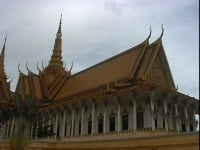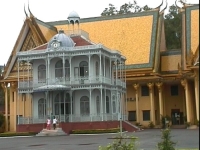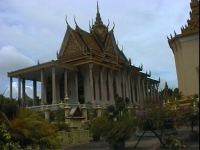CAMBODIA - A Brief Guide.
Created | Updated Jun 21, 2003
Royal Palace and Silver Pagoda

From the road, the most impressive thing about this temple/palace complex is the Chan Chaya Pavillion.
Built as an impressive entranceway into the site, classical dance performances used to be put on within. Thanks to the Khmer Rouge there is now very little classical dance performed anywhere in the country.
 A note for the traveller; the entrance is now to be found between the palace and the pagoda, 200 metres along the wall from the pavillion (not through the pavillion as has been stated in other guides).
A note for the traveller; the entrance is now to be found between the palace and the pagoda, 200 metres along the wall from the pavillion (not through the pavillion as has been stated in other guides).
I paid my entrance fee of $3 and $5 for my video camera (it is $3 for a still camera) and walked through to the main courtyard. The courtyard is dominated by the Throne Hall.
The present cement structure was built by King Sisowath in 1919, replacing the wooden structure that was built there in 1869.
The inside of the Throne Hall (no filming allowed) is mainly taken up with open space where coronations were held and diplomats presented their credentials. At one end is the raised throne and a number of statues. While the Hall is impressive, most of the precious and beautiful items were destroyed by the Khmer Rouge. Also within the courtyard are the Royal Treasury and Royal Offices. Off to one side is the Royal Residence Compound (which is closed to the public).

The most incongruous thing within the Royal Palace is the small grey building which was a gift from Napoleon III. The building is crammed full of paintings (of poor quality and worse state of repair), pots, vases, part of a Napoleon III Dinner Service and a display of medals. To be honest it was quite decrepit inside.
Leaving the Royal Palace and turning right you come to the North Gate, the entrance to the Silver Pagoda. Within the compound there are a number of temples (again, no filming inside is allowed) the most impressive being the eponymous Silver Pagoda.

The reason behind the name is that the floor consists of 5000 solid silver tiles, weighing in at a kilogramme a piece. Using five metric tonnes of silver for a floor has got to count as extravagant in anyone's book ($880,000 at current prices). Most of the floor is covered with lustrous red carpet, but I managed to feel the cool silver with my toes while looking at the exhibits.
The pagoda is also known as Wat Preah Keo (the Pagoda of the Emerald Buddha). The original wooden structure (built in 1892) is supposed to have been based upon 'Wat Phra Keo' in Bangkok. The present building was constructed in 1962.
Once again, more than half of the contents were destroyed by the Khmer Rouge (although they held it up as proof that they were respecting Cambodia's cultural heritage). Even so, it is worth visiting in order to see the Emerald Buddha. Sitting on a gilt pedestal on top of a stepped dais, the Buddah looks to be about two feet tall. It is supposedly made of Baccarat crystal and has highlights of gold.
Around the sides of the temple are cases full of statuettes of the Buddha, made from a variety of precious metals, along with commemorative medals and coins.
Apart from the Silver Pagoda there are a number of other temples and a library, although none are anywhere near as impressive. All around the compound wall is a mural, painted around 1900, depicting the Ramayana. It is in a terrible state of repair with at least the bottom third missing. I have read that it is being restored with help from Poland, but there is very little sign of that yet.
Leaving the compound you find yourself back where you started. There are a number of souvenir shops, but they looked to be the expensive 'Objet d'Art' type, so I gave them a miss.
